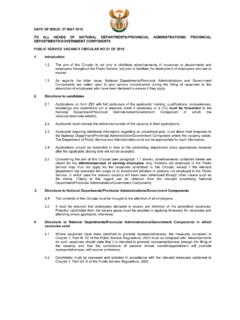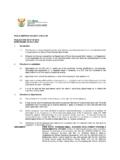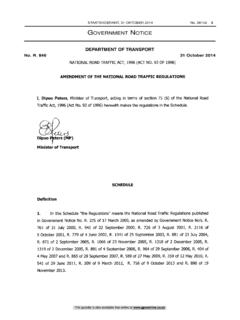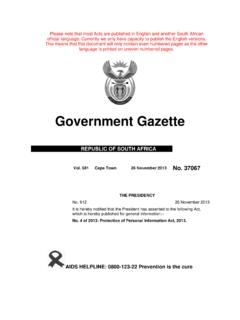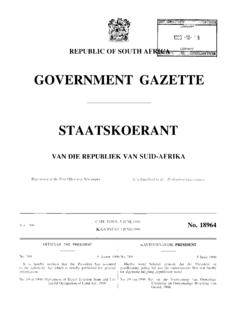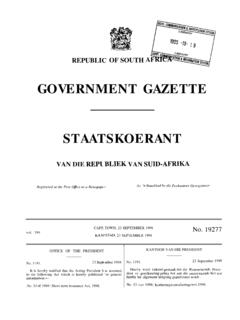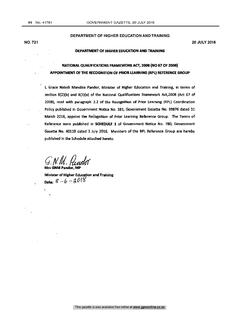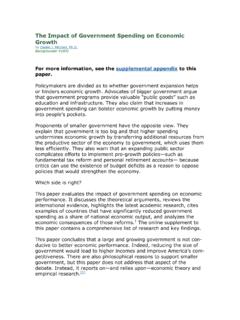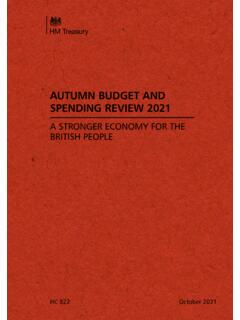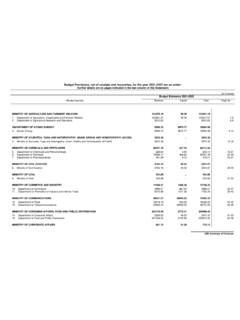Transcription of White Paper on Social Welfare - Gov
1 White Paper FOR Social . Welfare . August 1997. Principles, guidelines, recommendations, proposed policies and programmes for developmental Social Welfare in South Africa. Department of Welfare Private Bag X901. Pretoria 0001. Republic of South Africa Preamble Chapter 1: South African Social Welfare Context Part I: Policy framework Chapter 2: Proposed National Developmental Social Welfare Strategy Chapter 3: Institutional Arrangements Chapter 4: Human Resource Development Chapter 5: Legislation Chapter 6: Finance and Budgeting Part II: Delivery System Chapter 7: Social Security Chapter 8: Enhancing Social Integration - Section 1: The family and the life cycle - Section 2: Women - Section 3: People with disabilities - Section 4: Special needs and problems Glossary Annexure: Legislation PREAMBLE. 1. South Africans are called upon to participate in the development of an equitable, people-centred, democratic and appropriate Social Welfare system.
2 The goal of developmental Social Welfare is a humane, peaceful, just and caring society which will uphold Welfare rights, facilitate the meeting of basic human needs, release people's creative energies, help them achieve their aspirations, build human capacity and self-reliance, and participate fully in all spheres of Social , economic and political life. 2. South Africans will be afforded the opportunity to play an active role in promoting their own well-being and in contributing to the growth and development of our nation. The challenge facing the Welfare system is to devise appropriate and integrated strategies to address the alienation and the economic and Social marginalisation of vast sectors of the population who are living in poverty, are vulnerable, and have special needs. An intersectoral response is needed within Government and between Government and civil society to adequately address Welfare needs.
3 A further challenge is to address past disparities and fragmentation of the institutional framework in the delivery of Welfare services. 3. The Ministry for Welfare and Population Development is committed to the continuity of existing services whilst at the same time re-orientating such services towards developmental approaches. The Ministry will strive to achieve the above Social goals in a collaborative partnership with individuals, organisations in civil society and the private sector in keeping with the values, goals and priorities of the Reconstruction and Development Programme. 4. The approach and strategies contained in this White Paper for Social Welfare will inform the restructuring of services and Social Welfare programmes in both the public and the private sectors. The identified principles, guidelines and recommendations for developmental Social Welfare policies and programmes will be implemented progressively.
4 A five-year strategic plan of action will be developed. This plan will provide details on goals, objectives, activities, time frames, progress indicators, costing, and the parties responsible for the implementation of Social Welfare programmes. 5. This White Paper has been drawn up with the full participation of the stakeholders in the Welfare field. It is a negotiated policy framework and strategy, and it charts a new path for Social Welfare in the promotion of national Social development. The proposed direction of the White Paper is in line with the approach advocated by the United Nations World Summit for Social Development, held on 6 to 12 March 1995. CHAPTER 1. SOUTH AFRICAN Social Welfare CONTEXT. Social DEVELOPMENT CONTEXT. Economic growth and income distribution 1. South Africa has experienced declining economic growth rates over the past two decades, with the average annual growth rate of the Gross Domestic Product (GDP).
5 Falling below the annual population growth rate. This situation has resulted in a decrease in per capita income, and increasing poverty and pressure on the Welfare system to meet basic human needs. Inflation has affected the capacity of poor families to meet their needs. Further, low levels of economic growth and income are also associated with low levels of savings. This means that when individuals and families become vulnerable, they have limited resources on which to draw. Extreme inequality in the distribution of income exists among racial groups and households. The poorest 40% of households in South Africa earn less than 6% of total national income, whilst the richest 10% earn more than half of the national income. Great poverty exists alongside extreme wealth. About a third (35,2%) of all South African households, amounting to 18 million people, are living in poverty.
6 African households, households in rural areas, especially those headed by women in rural areas, are the most affected. Over half (54%) of all South Africa's children live in poverty1. Unequal income distribution has severely hampered development, particularly that of people in rural areas, who are generally poorer than their urban counterparts. In 1993. the average per capita income of rural Africans was only R151 per month, compared to metropolitan incomes of R335. Rural households rely mainly on remittances and state Social grants for income. Remittances make up a tenth of household income and Social grants account for about a quarter of household income in rural areas. However, many rural households and their extended families do not have access to reliable remittances, wages and/or resources to generate enough support for themselves. Employment 2. South Africa is characterised by large-scale unemployment in the formal sector of the economy.
7 The formal economy created an estimated 350 000 employment opportunities between 1980 and 1991, while the extended labour force grew by 4,5 million people. During this time, the number of people who were unemployed or in the informal sector (32%) more than doubled, while up to 20% of the extended labour force had to make a living from subsistence agriculture. Unemployment has been severe among women, especially those in rural areas, as well as among young people under the age of 24. Nearly a third of black people in this group were unemployed, as were just under 20% of those aged 25 to 34. Unemployment among people with disabilities is high. The formal sector of the economy is becoming less labour-intensive and can only provide employment for half of the labour force. It needs fewer, but better skilled people than in the past to produce the same level of output.
8 The labour force is relatively young and has a low overall skills level owing to poor educational opportunities. The South African economy has not been able to supply sufficient employment opportunities for all who want to work. Unemployment has increased the vulnerability of many households. In addition, the market also makes little provision for those with special needs, such as people with disabilities. Because people do not have secure and sustainable livelihoods, many turn to the Welfare system for income maintenance and Social support. Access to Social services 3. Poverty cannot be measured by income alone, nor can an anti-poverty programme only address income enhancing measures. This necessitates a multi-sectoral and an integrated approach. Education is one of the most important factors determining employment and thus income. There is a close association between poverty and a lack of education.
9 Illiteracy varies from 27% in metropolitan areas to 50% in rural areas. Illiteracy among coloureds (68%) and Africans (61%) in rural areas is higher than the national average. The lack of education of the head of a household is closely correlated with poverty in households. Of the 7,1 million people between the ages of 16 and 24 years, approximately 2,1. million have not matriculated and do not attend school. For more than a third, this lack of education is due either to a lack of money or to family responsibilities. The lack of education, employment opportunities and access to services has deprived many people of their dignity and the ability to look after themselves. These factors necessitate the need for additional support mechanisms to allow people to live in some degree of comfort and security. Access to Social Welfare 4. South Africa has embarked on the arduous task of socio-political and economic reform.
10 While sound economic policies and a well-functioning labour market are essential for growth and employment generation, by themselves, they are not sufficient. To reap the benefits, South Africa must invest in people; that is, develop the human capital which is essential for increasing productivity and moving people out of poverty. Internationally, the strategy that has proved most effective in improving economic and Social well-being consists of three elements: labour-absorbing growth, equitable investments in education, health care and Social support for poor and vulnerable groups. 5. Welfare support limits the impact of market and policy failures. It also eases the transition experienced by many workers owing to changes in work and living conditions, as well as the weakening of Social and family networks in providing Social support and security. Social Welfare policies and programmes which provide for cash transfers, Social relief, and enabling and developmental services ensure that people have adequate economic and Social protection during times of unemployment, ill-health, maternity, child- rearing, widowhood, disability, old age and so on.
